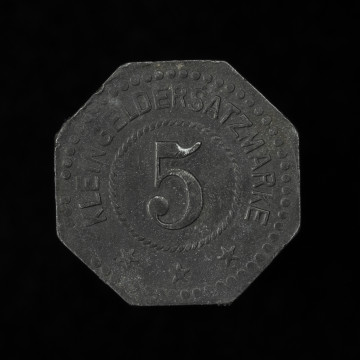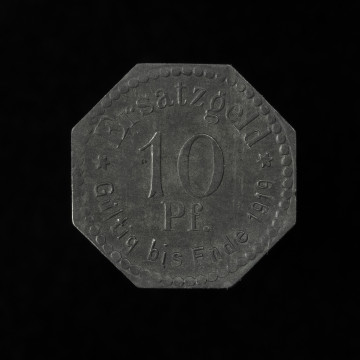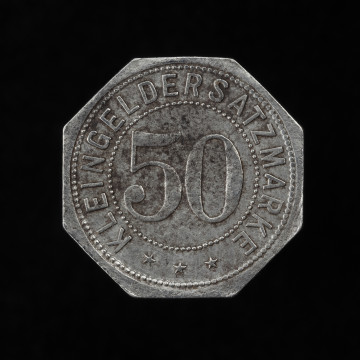
5 pfennig
1916 — 1925
National Museum in Szczecin
Part of the collection: Scrip
The scarcity of official small coins during the First World War in Germany resulted in the mass minting of their local equivalents. Large commercial businesses experiencing customer service problems also joined in the issuing of replacement coins. One of these was Rudolph Karstadt's department store in Szczecin. It commissioned two series of replacement coins through the company L. Chr. Lauer of Nuremberg. The first zinc octagonal tokens were probably struck in the following four denominations: 1, 5, 10 and 50 pfennig. With some experience of the market demand, a larger number of 1-pfennig were then ordered, this time struck in iron. The large issue of this coin is evidenced by the existence of several varieties of stamps, which wore out much more quickly when in contact with iron blanks than when working with the more yielding zinc. The coin presented here was issued in the second edition. A point to note is that zinc was a strategic material, more difficult to obtain, so minting coins in iron was probably less costly. On the other hand, iron coins were much more resistant to wear in circulation and to corrosive agents than zinc, which probably also led to the choice of this metal. Therefore, both cheaper and more practical money was available. Unfortunately, the replacement coins minted by a number of issuers (more than 18,200 are known) did not remain in circulation for long. The population hoarded all metal money en masse as a kind of alternative to the bullion coins already withdrawn from circulation. Additionally, the mintage was after all too small with respect to the needs. Mieszko Pawłowski
Other names
1 Pfennig, Notgeld
Author / creator
Object type
token coin
Technique
coining
Material
iron
Origin / acquisition method
acquisition
Creation time / dating
Creation / finding place
Owner
Muzeum Narodowe w Szczecinie (1945- )
Identification number
Location / status

1916 — 1925
National Museum in Szczecin

1917
National Museum in Szczecin

1901 — 1925
National Museum in Szczecin
DISCOVER this TOPIC
Museum of King Jan III's Palace at Wilanów
DISCOVER this PATH
Educational path